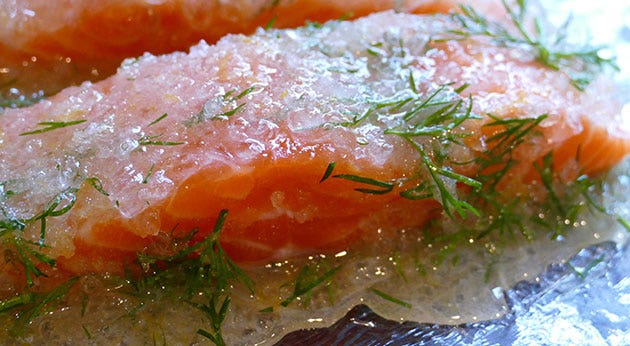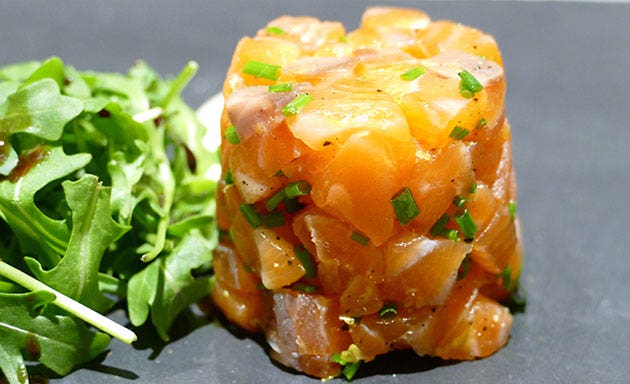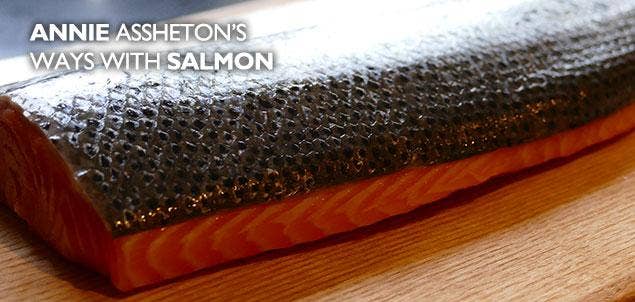As an ingredient, salmon must be one of the most versatile around. Baked, poached, roasted or fried; raw, cured, confit or smoked; whole, filleted, flaked or sliced; for crowds or for couples; the options are practically endless and that’s before we’ve even started to consider flavour combinations. In fact my greatest challenge here is to decide which preparations and recipes to talk about from the enormous number of possibilities. With a flavour that can stand up perfectly well by itself or with the simplest of accompaniments it is also a very easy fish to pair with all sorts of more assertive plate fellows. Indeed, the rather fatty flavour of farmed salmon can really benefit from being cut through by something really punchy.
In one of the later rounds of MasterChef when there were just six of us left, we cooked dinner for a dining room full of research fellows and students at New College, Oxford. I was making the starter along with one of the other contestants (in fact with Tim Anderson, the eventual winner) and we were tasked with preparing 165 plates of salmon prepared three ways. The dish included salmon confit for which whole sides were cooked for two hours in olive oil with lemon and dill before being flaked into rings and topped with pea shoots and a dill and caper dressing. Next to that on the plate was salmon loin, long strips of which were cured in salt, sloe gin and juniper berries. Each strip was then rolled in Brique pastry before being sliced into individual pieces. These were fried off at the very last minute before being served on top of Oxford Chutney. Finally, there was salmon mousse, rolled in smoked salmon and paired with watercress, chive mayonnaise and pink peppercorns.
I’ll never forget the overwhelming volume of ingredients that had to be prepared and the logistics of plating up for 165 guests. Looking back, it seems extraordinary that I ever wanted to see any salmon again but actually the whole experience was so fantastically inspiring, adrenalin pumping and revelatory that I came away longing to try out all those techniques and flavour combinations at home as soon as I could. I don’t think I have ever created the whole dish again (much to my husband’s disappointment, many hints were dropped) but nonetheless it has provided a huge amount of inspiration for me ever since. It involved processes and ideas that were completely new to me and, like a kind of salmon masterclass, opened up a wealth of possibilities.
 Annie's salmon curing process
Annie's salmon curing processEver since then, curing has been one of my favourite techniques to use with salmon. It preserves the glorious colour and firms up the texture of the fish while intensifying and enhancing the flavour. What’s more it’s brilliantly easy to do, has to be done well in advance and basically ticks all the boxes when you are looking for a delicious, straightforward and seriously impressive starter which works all year round. I have cured salmon in sloe gin a few times since Oxford and it is seriously good, but mainly I tend to prefer saving my home-made tipple to enjoy on its own after dinner. The cure I regularly use is a very straightforward affair, as shown in the recipe below, but certainly complements the fish beautifully.
Quick Cook Oriental Salmon
For altogether more everyday use, salmon is top of my list of ingredients that I go to when I want a supper that’s quick to put together but makes it look as though I have made a bit of an effort. On those days when I’ve got a bit distracted by something and suddenly realise that supper needs to be on the table in 15 minutes flat it’s always a huge relief to find a couple of salmon fillets in the fridge. The rescue salmon recipe that I turn to in this situation also happens to be one of my husband’s favourites so everyone ends up happy. All you have to do is combine equal amounts of runny honey and dark soy sauce with half the amount of mirin. I usually use about 50ml each of honey and soy, and 25ml of mirin for two of us; obviously you can scale it up or down just using the same proportions. If you don’t have any mirin don’t panic, it will be fine without it but it’s worth having some in your cupboard; it lasts for ages and is really useful, particularly since this marinade goes brilliantly with pork too.For salmon though, pour the soy mixture over a couple of fillets and bake at 180°C for 8 minutes (or closer to 200°C in a non-fan oven). I promise it doesn’t need any longer unless your fillets are enormous; the only way to make this combination anything less than scrumptious is to overcook it!
While the salmon is in the oven cook some fine egg noodles (which normally only take three or four minutes) and something green to go with it; almost anything will do depending on what’s in season: cavolo nero, pak choi, tender stem broccoli, spinach or green beans would all be excellent. The salmon sits on top of the noodles with the sauce poured over it all and the greens on the side. This is such a star of a dish that as well as being a regular on our mid-week supper table I have frequently dressed it up for special occasions. Some finely chopped spring onions stirred through the noodles add an element of piquancy to help cut through the sweetness of the sauce and oiliness of the fish, and some toasted sesame seeds sprinkled on top give a lovely finish as well as another layer of flavour. It is easily smart enough for supper with friends and works brilliantly in smaller form for bowl food at bigger parties. Sometimes I use a slightly more exotic type of noodle such as Udon or Soba, both of which are very available at larger supermarkets. Rice, of course, works very well too, soaking up all that sticky sauce, but I only use it when I have more than ten minutes to get supper onto the table.
Summer Salmon Dish
As with many meats and other fish which don’t enjoy being overcooked, the best and most succulent results often come from using larger pieces of salmon. One of my very favourite more summery salmon recipes is based on one by Rick Stein and is brilliant when you have friends for the weekend.It involves sandwiching two well-seasoned sides of salmon together with salsa verde and sitting that on top of a layer of sliced tomatoes sprinkled with capers, slivers of garlic and thyme leaves. Spooning a few tablespoons of rapeseed oil (or olive oil if that is your preference) and a splash of water over that layer before adding the salmon both stops anything from sticking and forms a lovely sauce.
You can get it all ready in advance and then just put it through the oven for 25 minutes at 200°C before letting it rest for a few minutes and slicing it into portions. It should still be a bit pink in the middle. Rick serves this with new potatoes and green beans dressed with spring onions and a Dijon mustard dressing and I can think of very few better dishes to enjoy with a glass of rose on a lovely summer evening with friends.
 Annie's cured salmon, plated and ready to serve.
Annie's cured salmon, plated and ready to serve.Cured Salmon Recipe with Horseradish Cream and Rocket
Serves 4Ingredients: 4 salmon fillets (about 140g each) skinned
For the cure: 100g rock salt 100g sugar 1 lemon, zest and juice Small bunch of dill
To dress the salmon: 1 lemon, zest only Small bunch of chives, finely chopped A good grinding of black pepper
To serve: 100 ml crème fraiche 1 tbsp creamed horseradish (or to taste) Squeeze of lemon juice Lightly dressed rocket
Mix together the salt, sugar and lemon zest and then squeeze over about half of the juice to begin with, adding more if there’s not enough to make a paste. Chop the dill and stir through.
Spread a double layer of cling film out on your work top and put about half of the paste onto it. Sit the salmon fillets on top and then add the rest of the paste, making sure that each fillet is well coated. Wrap the cling film around to make a tight parcel and put the whole thing into a freezer bag or sit it on a plate to catch any escaping juices and chill the salmon for approximately 12 hours.
When the curing time is up unwrap the salmon fillets and rinse them very well under a cold running tap. Dry them off well with kitchen paper and then, using a sharp knife, slice the fillets in half horizontally (or into thirds if they are very thick) and then cut each slice as evenly as possible into ½cm cubes. Put it all into a bowl and add the lemon zest, chives and pepper, stirring it all through very thoroughly.
Using kitchen paper, rub some sunflower or similar oil around the inside of four moulds or ramekins. Divide the salmon between them and press it down firmly. Cover with cling film and put in the fridge until needed.
 Transfer the cured salmon into moulds or ramekins for serving
Transfer the cured salmon into moulds or ramekins for servingMix the crème fraiche with the horseradish, a squeeze of lemon and some salt. Taste and adjust the flavours as necessary.
To serve, use your hands to scrunch the rocket into four well behaved balls and place one on each plate. Unmould the cured salmon (it can be easier to knock it down onto a board and transfer to the plates with a palette knife) and add a spoonful of horseradish cream.
2017-02-13 16:22:46
36 view(s) 


